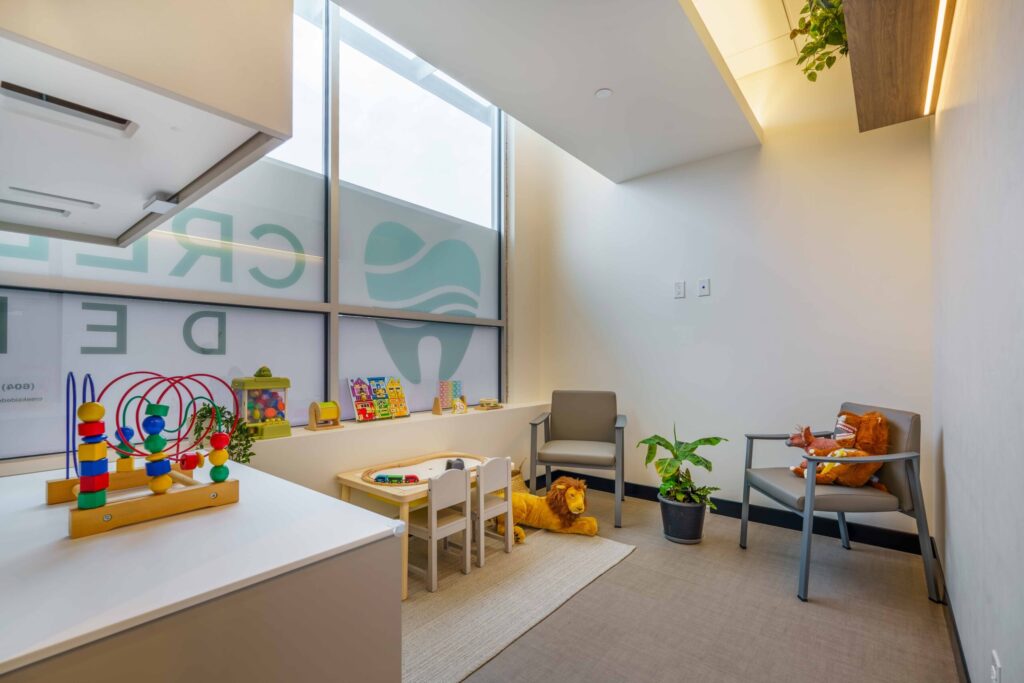Why Child-Friendly Dental Spaces Matter
Children’s first impressions of dental visits often shape their attitudes toward oral health for life. At Morristown Orthodontics, we believe that creating a welcoming environment for our youngest patients isn’t just nice—it’s necessary for their long-term health.
Research shows that dental anxiety often begins in childhood. A 2023 study published in the Journal of Dental Research found that patients who had positive dental experiences as children were 60% less likely to develop dental anxiety as adults.
When children enter a space designed with them in mind—colorful, playful, and engaging—their anxiety decreases significantly. At Morristown Orthodontics, parents tell us their children actually look forward to visits, asking days in advance, “When do we get to go to the dentist?”
Creating a Comprehensive Approach
Our team uses age-appropriate language, getting down to eye level with young patients and explaining procedures in ways children understand. For example, we might describe the dental explorer as a “tooth counter” and X-ray machines as “tooth cameras.”
Small adaptations to the clinical setting make an enormous difference in a child’s comfort level. Child-sized dental chairs, ceiling-mounted TVs, and sunglasses to shield eyes from bright lights all contribute to a more positive experience.
For best practices in pediatric communication, we recommend reviewing guidelines from the American Academy of Pediatric Dentistry (AAPD).
Designing the Perfect Kids’ Waiting Area
The waiting area serves as your practice’s first impression. Our friends at Creekside Dental in Langley have recently opened with an exceptional example of a child-friendly waiting area. Their new kids waiting room demonstrates how thoughtful design creates an engaging environment for children of all ages.
Children experience time differently than adults. A five-minute wait can feel unbearably long to a child with nothing to do. Age-appropriate books, digital tablets with educational dental games, and coloring activities give children creative outlets while teaching them about oral health in engaging ways.
For additional design inspiration, check out the American Dental Association’s guide on building kid-friendly offices (ADA.org).

Supporting Children with Unique Needs
Every child deserves a comfortable dental experience, including those with sensory sensitivities or special healthcare needs. Quiet rooms for children who need reduced sensory input, flexible scheduling options, and visual schedules that help children understand what to expect all show consideration for diverse needs.
For more resources, visit Autism Speaks Dental Tool Kit, which offers helpful strategies for supporting children on the autism spectrum during dental visits.
Don’t Forget the Parents
When parents feel comfortable, their children pick up on that confidence. Comfortable adult seating near children’s areas, easily accessible information about children’s oral health, and simple amenities show you value parents’ comfort during what might be a stressful time for the family.
The Mayo Clinic also emphasizes that a parent’s demeanor has a direct influence on a child’s response to medical and dental appointments.
Implementation Tips
Transforming your practice doesn’t require an enormous budget. Start with staff training before making physical changes. Implement changes gradually, measuring their impact. Collect feedback from children and parents through conversation or simple drawing activities where kids can share what they liked about their visit.
Visiting other child-friendly practices like Creekside Dental in Langley can provide inspiration and practical ideas that have been tested in real-world settings.
The Business Benefits
Creating child-friendly environments makes good business sense. Families with multiple children represent significant lifetime value. Parents share positive experiences widely, creating organic marketing. Child patients eventually become adult patients who already trust your practice. Reduced appointment cancellations due to child anxiety improves scheduling efficiency.
The Harvard Business Review has written extensively on how improving customer (or patient) experience leads to long-term business growth, especially in service-based industries like healthcare.
Conclusion
At Morristown Orthodontics, we believe that creating welcoming environments for children isn’t just about decorations—it’s about setting the foundation for lifelong oral health. If you’re looking for inspiration, our friends at Creekside Dental in Langley have recently opened with an exceptional child-friendly environment worth checking out.
Key Takeaway
Creating a welcoming dental environment for children requires thoughtful design, staff training, and genuine care. When children feel comfortable in dental settings, they develop positive attitudes toward oral health that last a lifetime, benefiting both their health outcomes and your practice’s success.

